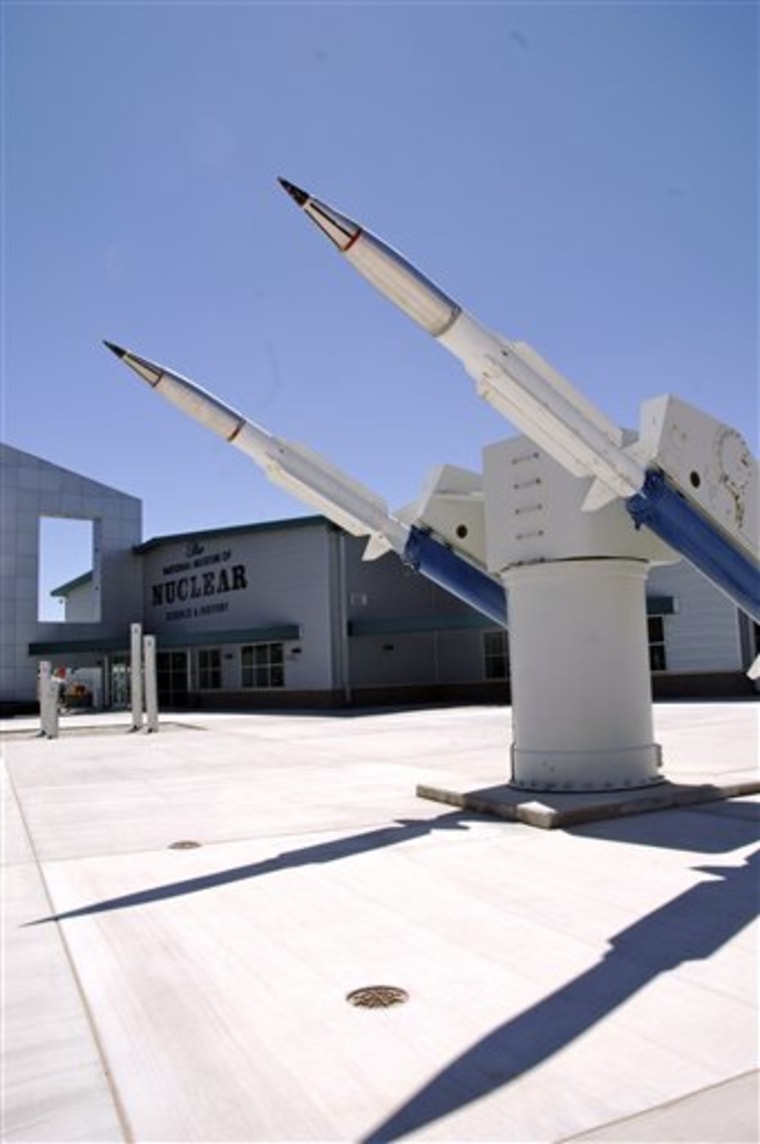Peek into a 320-foot blast crater in the Nevada desert or descend a Titan II missile silo in Arizona for a look at two of many "atomic tourism" sites around the world that offer history and sometimes lessons from the deadly aftermath of the nuclear age.
The crisis in Japan has boosted interest in nuclear-related museums and plants, once-secret Manhattan Project complexes and areas laid waste by disaster.
"Anecdotal evidence suggests that there is a great interest in things nuclear in general, and specifically about the Japanese situation," said Allan Palmer, executive director of the Atomic Testing Museum and Nevada Test Site Historical Foundation in Las Vegas.
Attendance was up 12 percent on a recent weekend at the museum, located minutes from the Strip that came into its own at the dawn of the Atomic Age.
At the National Museum of Nuclear Science & History in Albuquerque, N.M., attendance jumped about 20 percent on a recent weekend as work continued at the Fukushima Dai-ichi reactors after the earthquake and tsunami wiped out power to northern Japan.
"Folks definitely want information about nuclear reactors and nuclear radiation," said Jeanette Miller, a spokeswoman for Albuquerque museum.
Balance, facts and truth
One of the museum's docents, retired physicist Duane Hughes, said inquiring visitors aren't jittery but seem confused about reports of the dangers in Japan. The museum hosted a specialist to brief docents on what's going on.
"We try to give people a balanced, factual, truthful response," Hughes said. "I didn't see anyone who is showing any emotional situations like, 'Oh my God, the sky is falling.'"
Miller and other museum officials said spring break, along with special events like the NCAA basketball tournament in Tucson, Ariz., are contributing to increased foot traffic.
Other locations that played important roles in the development of nuclear technology stay busy for tours much of the year.
Elsewhere, the Japan disaster coincides with the expected start of government-sponsored tours of Chernobyl in Ukraine later in the spring. They'll include a look at nearby Pripyat 25 years after the worst nuclear power plant accident in history turned it into a ghost town. Tours through private operators began about a year ago and can cost up to $250 per person.
Visitors to Chernobyl see both activity and desolation.
Heavy trucks and other machinery cross the grounds, working on the early stages of a project to build a gargantuan hangar-shaped shelter over the building housing the exploded reactor. In Pripyat, which once housed the plant's workers, high-rise apartment blocks stand empty and are slowly disintegrating.
War and peace
In Japan, Nagasaki and Hiroshima have museums covering war, reconstruction and peace efforts. The Nagasaki Atomic Bomb Museum and the Hiroshima Peace Site offer minute-by-minute accounts, artifacts and memorials.
Is a virtual tour more your thing? Traffic on nuclear engineer Joseph Gonyeau's website, Nucleartourist.com, has skyrocketed. The site usually has about 94,000 unique visitors a month. The number of visits in March is up 119 percent, he said.
"People are asking a lot more questions," Gonyeau said. "This usually happens when problems occur at some plant."
Some atomic tourism stops:
TITAN MISSILE MUSEUM
The only Titan II missile silo open to the public in what was once among the most secret locations in the country. About 20 miles south of Tucson, take a guided tour into a Titan II silo about 35 feet underground. Experience a simulated launch. Among special tours: Museum staff will lead you and a group on a desert hike to explore the ruins of a missile site virtually untouched since it was abandoned more than 20 years ago.
NATIONAL MUSEUM OF NUCLEAR SCIENCE & HISTORY
In Albuquerque, the museum spans the dawn of the Atomic Age through the Cold War to modern nuclear medicine. Covers the secret Trinity test in the New Mexico desert. Has planes, rockets and missiles on display outside. Features casings of Fat Man and Little Boy bombs — the types dropped on Nagasaki and Hiroshima. Learn about the uranium cycle and take "Radiation 101." Little Albert's Lab offers hands-on science for kids.
TRINITY TEST SITE
Site of first atomic bomb test on July 16, 1945, located on the northern end of the White Sands Missile Range in south-central New Mexico. The 19-kiloton explosion led to a quick end to the war in the Pacific and ushered in the Atomic Age. White Sands hosts two "open houses" on the Trinity site every year, in April and October. Tours are self-guided. This year's dates are April 2 and Oct. 1. Included is ground zero, where the bomb was placed on a 100-foot steel tower. Contact the base public affairs office for visitor details.
THE ATOMIC TESTING MUSEUM
Minutes from the Las Vegas Strip, the museum covers the Nevada Test Site, now the Nevada National Security Site, where atmospheric weapons tests were conducted from 1951 to 1962. Tours of the site 65 miles northwest of the city start at the museum but book up more than six months in advance. See remnants of a house and bridge used for tests, peek inside one of the many craters that left the area a moonscape.
HANFORD NUCLEAR RESERVATION
The world's first full-scale nuclear reactor is one stop on tours of the southeastern Washington state reservation created as part of the Manhattan Project to build the atomic bomb. Now, more than two decades after it stopped producing plutonium, Hanford is the nation's most contaminated nuclear site. From a distance, visitors watch white-suited workers bury mercury-tainted soil in a landfill and see cranes building a plant to encase radioactive waste in glass. Tour details.
AMERICAN MUSEUM OF SCIENCE & ENERGY
In Oak Ridge, Tenn., another Manhattan Project secret city, fuel was enriched for the world's first atomic bomb. A 20-minute video at the museum goes into depth on the town's story. Includes photos, documents, models and hands-on activities. Other energy sources are also covered.
